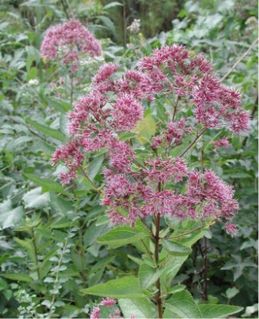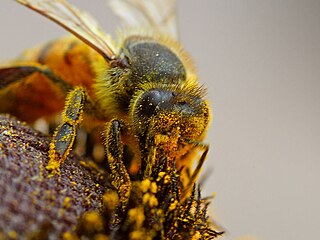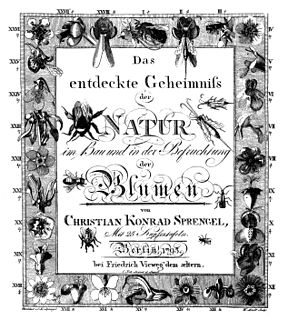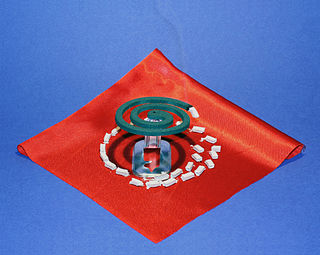
Nocturnality is an animal behavior characterized by being active during the night and sleeping during the day. The common adjective is "nocturnal", versus diurnal meaning the opposite.

A pollinator is an animal that moves pollen from the male anther of a flower to the female stigma of a flower. This helps to bring about fertilization of the ovules in the flower by the male gametes from the pollen grains.

Petals are modified leaves that surround the reproductive parts of flowers. They are often brightly colored or unusually shaped to attract pollinators. Together, all of the petals of a flower are called a corolla. Petals are usually accompanied by another set of special leaves called sepals, that collectively form the calyx and lie just beneath the corolla. The calyx and the corolla together make up the perianth. When the petals and sepals of a flower are difficult to distinguish, they are collectively called tepals. Examples of plants in which the term tepal is appropriate include genera such as Aloe and Tulipa. Conversely, genera such as Rosa and Phaseolus have well-distinguished sepals and petals. When the undifferentiated tepals resemble petals, they are referred to as "petaloid", as in petaloid monocots, orders of monocots with brightly coloured tepals. Since they include Liliales, an alternative name is lilioid monocots.

In biology, coevolution occurs when two or more species reciprocally affect each other's evolution.

A wildlife garden is an environment created by a gardener that serves as a sustainable haven for surrounding wildlife. Wildlife gardens contain a variety of habitats that cater to native and local plants, birds, amphibians, reptiles, insects, mammals and so on. Establishing a garden that emulates the environment before the residence was built, and/or renders the garden similar to intact wild areas nearby, will allow natural systems to interact and establish an equilibrium, ultimately minimizing the need for gardener maintenance and intervention. Wildlife gardens can also play an essential role in biological pest control, and also promote biodiversity, native plantings, and generally benefit the wider environment.

In ecology, a biological interaction is the effect that a pair of organisms living together in a community have on each other. They can be either of the same species, or of different species. These effects may be short-term, like pollination and predation, or long-term; both often strongly influence the evolution of the species involved. A long-term interaction is called a symbiosis. Symbioses range from mutualism, beneficial to both partners, to competition, harmful to both partners. Interactions can be indirect, through intermediaries such as shared resources or common enemies.
The noindex value of an HTML robots meta tag requests that automated Internet bots avoid indexing a web page. Reasons why one might want to use this meta tag include advising robots not to index a very large database, web pages that are very transitory, web pages that are under development, web pages that one wishes to keep slightly more private, or the printer and mobile-friendly versions of pages. Since the burden of honoring a website's noindex tag lies with the author of the search robot, sometimes these tags are ignored. Also the interpretation of the noindex tag is sometimes slightly different from one search engine company to the next.
A nectar source is a flowering plant that produces nectar as part of its reproductive strategy. These plants create nectar, which attract pollinating insects and sometimes other animals such as birds.

Entomophily or insect pollination is a form of pollination whereby pollen of plants, especially but not only of flowering plants, is distributed by insects. Flowers pollinated by insects typically advertise themselves with bright colours, sometimes with conspicuous patterns leading to rewards of pollen and nectar; they may also have an attractive scent which in some cases mimics insect pheromones. Insect pollinators such as bees have adaptations for their role, such as lapping or sucking mouthparts to take in nectar, and in some species also pollen baskets on their hind legs. This required the coevolution of insects and flowering plants in the development of pollination behaviour by the insects and pollination mechanisms by the flowers, benefiting both groups.

Zoophily is a form of pollination whereby pollen is transferred by animals, usually vertebrates but may include invertebrates, particularly by hummingbirds and other birds, and bats, but also by monkeys, marsupials, lemurs, bears, rabbits, deer, rodents, lizards, and other animals. Zoophilous species, like entomophilous species, frequently evolve mechanisms to make themselves more appealing to the particular type of pollinator, e.g. brightly colored or scented flowers, nectar, and appealing shapes and patterns. These plant-animal relationships are often mutually beneficial because of the food source provided in exchange for pollination. Zoophilous species include Arctium, Acaena, and Galium aparine.

Nectar is a sugar-rich liquid produced by plants in glands called nectaries, either within the flowers with which it attracts pollinating animals, or by extrafloral nectaries, which provide a nutrient source to animal mutualists, which in turn provide antiherbivore protection. Common nectar-consuming pollinators include mosquitoes, hoverflies, wasps, bees, butterflies and moths, hummingbirds, honeyeaters and bats. Nectar plays an important role in the foraging economics and overall evolution of nectar-eating species; for example, nectar and its properties are responsible for the differential evolution of the African honey bee, A. m. scutellata and the western honey bee.

A flower, sometimes known as a bloom or blossom, is the reproductive structure found in flowering plants. The biological function of a flower is to effect reproduction, usually by providing a mechanism for the union of sperm with eggs. Flowers may facilitate outcrossing or allow selfing. Some flowers produce diaspores without fertilization (parthenocarpy). Flowers contain sporangia and are the site where gametophytes develop. Many flowers have evolved to be attractive to animals, so as to cause them to be vectors for the transfer of pollen. After fertilization, the ovary of the flower develops into fruit containing seeds.
An ecological island is not necessarily an island surrounded by water, but is an area of land, isolated by natural or artificial means from the surrounding land, where a natural micro-habitat exists amidst a larger differing ecosystem.

Ornithophily or bird pollination is the pollination of flowering plants by birds. This sometimes coevolutionary association is derived from insect pollination (entomophily) and is particularly well developed in some parts of the world, especially in the tropics, Southern Africa, and on some island chains. The association involves several distinctive plant adaptations forming a "pollination syndrome". The plants typically have colourful, often red, flowers with long tubular structures holding ample nectar and orientations of the stamen and stigma that ensure contact with the pollinator. Birds involved in ornithophily tend to be specialist nectarivores with brushy tongues and long bills, that are either capable of hovering flight or light enough to perch on the flower structures.
The ecology of Banksia refers to all the relationships and interactions among the plant genus Banksia and its environment. Banksia has a number of adaptations that have so far enabled the genus to survive despite dry, nutrient-poor soil, low rates of seed set, high rates of seed predation and low rates of seedling survival. These adaptations include proteoid roots and lignotubers; specialised floral structures that attract nectariferous animals and ensure effective pollen transfer; and the release of seed in response to bushfire.

Pollination syndromes are suites of flower traits that have evolved in response to natural selection imposed by different pollen vectors, which can be abiotic or biotic, such as birds, bees, flies, and so forth. These traits include flower shape, size, colour, odour, reward type and amount, nectar composition, timing of flowering, etc. For example, tubular red flowers with copious nectar often attract birds; foul smelling flowers attract carrion flies or beetles, etc.

A pest-exclusion fence is a barrier that is built to exclude certain types of animal pests from an enclosure. This may be to protect plants in horticulture, preserve grassland for grazing animals, separate species carrying diseases from livestock, prevent troublesome species entering roadways, or to protect endemic species in nature reserves. These fences are not necessarily traditional wire barriers, but may also include barriers of sound, or smell.

Christian Konrad Sprengel was a German naturalist, theologist, and teacher. He is most famous for his research on plant sexuality. Sprengel was the first to recognize that the function of flowers was to attract insects, and that nature favoured cross-pollination. Along with the work of Joseph Gottlieb Kölreuter he set the foundations for the modern study of floral biology and anthecology although his work was not widely recognized until Charles Darwin examined and reconfirmed several of his observations.

Advertising in biology means the use of displays by organisms such as animals and plants to signal their presence for some evolutionary reason.
















